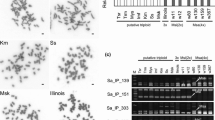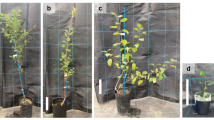Abstract
Natural Miscanthus grasses are useful for improving biomass production. We found a population of putative triploid interspecific hybrids between Miscanthus sacchariflorus and Miscanthus sinensis in southern Kyushu, Japan. This study aims to investigate its morphological variation, genetic structure, and origin. Miscanthus plants were collected from 114 points, mainly beside a river along a distance of 2.8 km in the Tashiro–Fumoto area. They resembled M. sacchariflorus but showed morphology intermediate between the two species. They had a nuclear DNA content corresponding to that of a hybrid between tetraploid M. sacchariflorus and diploid M. sinensis, and had species-specific alleles from both species revealed by DNA marker analysis. This indicates that the plants are triploid hybrids between M. sacchariflorus and M. sinensis. Genotyping using simple sequence repeat markers revealed only four genotypes among the hybrid population, of which two accounted for most plants. The genotypes showed mostly discrete geographical distributions. The two major genotypes showed contrasting phenotypes in pollen viability and in frequency of awns in florets. Some seeds collected from the population germinated and the seedlings showed a wide range of nuclear DNA content from diploid to tetraploid. In this area, many M. sinensis plants also grew, but we could not find M. sacchariflorus. The hybrid Miscanthus might be selected due to its improved adaptability introduced from M. sinensis. Furthermore, genetic and phenotypic characterization suggests the polyphyletic origin and clonal propagation of this population. Such partially fertile hybrids could be interesting for the improvement of Miscanthus as a biomass crop.






Similar content being viewed by others
References
Clifton-Brown J, Chang YC, Hodkinson TR (2008) Miscanthus: Genetic resources and breeding potential to enhance bioenergy production. In: Vermerris W (ed) Genetic improvement of bioenergy crops. Springer, New York, pp 273–294
Nishiwaki A, Mizuguti A, Kuwabara S, Toma Y, Ishigaki G, Miyashita T, Yamada T, Matuura H, Yamaguchi S, Rayburn AL, Akashi R, Stewart JR (2011) Discovery of natural Miscanthus (Poaceae) triploid plants in sympatric populations of Miscanthus sacchariflorus and Miscanthus sinensis in southern Japan. Am J Bot 98:154–159
Hirayoshi I, Nishikawa K, Kubono M, Murase T (1957) Cytogenetical studies on forage plants (VI). On the chromosome number of ogi (Miscanthus sacchariflorus). Res Bull Fac Agric Gifu Univ 8:8–13, [In Japanese with English summary]
Moon YH, Cha YL, Choi YH, Yoon YM, Koo BC, Ahn JW, An GH, Kim JK, Park KG (2013) Diversity in ploidy levels and nuclear DNA amounts in Korean Miscanthus species. Euphytica 193:317–326
Feng XP, Lourgant K, Castric V, Saumitou-Laprade P, Zheng BS, Jiang D, Brancourt-Hulmel M (2014) The discovery of natural Miscanthus accessions related to Miscanthus × giganteus using chloroplast DNA. Crop Sci 54:1645–1655
Lewandowski I, Clifton-Brown JC, Scurlock JMO, Huisman W (2000) Miscanthus: european experience with a novel energy crop. Biomass Bioenerg 19:209–227
Heaton EA, Dohleman FG, Miguez AF, Juvik JA, Lozovaya V, Widholm J, Zabotina OA, McIsaac GF, David MB, Voigt TB, Boersma NN, Long SP (2010) Miscanthus: a promising biomass crop. In: Kader JC, Delseny M (eds) Advances in botanical research, Vol 56. Elsevier, Amsterdam, pp 75–137
Rayburn AL, Crawford J, Rayburn CM, Juvik JA (2009) Genome size of three Miscanthus species. Plant Mol Biol Rep 27:184–188
Dwiyanti MS, Rudolph A, Swaminathan K, Nishiwaki A, Shimono Y, Kuwabara S, Matuura H, Nadir M, Moose S, Stewart JR, Yamada T (2013) Genetic analysis of putative triploid Miscanthus hybrids and tetraploid M. sacchariflorus collected from sympatric populations of Kushima, Japan. Bioenerg Res 6:486–493
Adati S, Mitsuishi S (1955) Wild growing plants of the Far east, especially Japan, suitable for breeding purposes. Part I. Karyological study in miscanthus (1). Bull Fac Agric Mie Univ 12:1–10
Linde-Laursen I (1993) Cytogenetic analysis of Miscanthus giganteus, an interspecific hybrid. Hereditas 119:297–300
Nielsen PN (1990) Elefantengrassanbau in Dänemark — Praktikerbericht. Pflug und Spaten 3:1–4 [In German]
Greef JM, Deuter M (1993) Syntaxonomy of Miscanthus × giganteus Greef-Et-Deu. Angew Bot 67:87–90
Głowacka K, Clark LV, Adhikari S, Peng J, Stewart JR, Nishiwaki A, Yamada T, Jørgensen U, Hodkinson TR, Gifford J, Juvik JA Sacks EJ (2015) Genetic variation in Miscanthus ×giganteus and the importance of estimating genetic distance thresholds for differentiating clones. Glob Change Biol Bioenergy 7:386–404
Honda M (1939) New report of plants in Japan XXXVIII. Bot Mag 53:144 [In Japanese]
Adati S (1958) Studies on the Miscanthus genus with special reference to the Japanese species suitable for breeding purposes as fodder crops. Bull Fac Agric Mie Univ 17:1–112 [In Japanese with English summary]
Ibaragi Y, Lim SH, Yook MJ, Chang CS, Kim DS (2013) Taxonomic notes on Korean miscanthus × ogiformis Honda (Poaceae)––a new record from Korea. J Jpn Bot 88:184–187
Clark LV, Brummer JE, Głowacka K, Hall MC, Heo K, Peng J, Yamada T, Yoo JH, Yu CY, Zhao H, Long SP, Sacks EJ (2014) A footprint of past climate change on the diversity and population structure of Miscanthus sinensis. Ann Bot 114:97–107
Chae WB, Hong SJ, Gifford JM, Lane Rayburn A, Sacks EJ, Juvik JA (2014) Plant morphology, genome size, and SSR markers differentiate five distinct taxonomic groups among accessions in the genus Miscanthus. Glob Change Biol Bioenergy 6:646–660
Jiang JX, Zhu MD, Ai X, Xiao L, Deng GT, Yi ZL (2013) Molecular evidence for a natural diploid hybrid between Miscanthus sinensis (Poaceae) and M. sacchariflorus. Plant Syst Evol 299:1367–1377
Anderson E, Stebbins GL (1954) Hybridization as an evolutionary stimulus. Evolution 8:378–388
Arnold ML, Cornman RS, Martin NH (2008) Hybridization, hybrid fitness and the evolution of adaptations. Plant Biosyst 142:166–171
Tsukaya H, Fukuda T, Yokoyama J (2003) Hybridization and introgression between Callicarpa japonica and C. mollis (Verbenaceae) in central Japan, as inferred from nuclear and chloroplast DNA sequences. Mol Ecol 12:3003–3011
Fukui K (1996) Plant chromosomes at mitosis. In: Fukui K, Nakayama S (eds) Plant chromosomes: laboratory methods. CRC Press, Boca Raton, FL, pp 1–17
Akiyama Y, Conner JA, Goel S, Morishige DT, Mullet JE, Hanna WW, Ozias-Akins P (2004) High-resolution physical mapping in Pennisetum squamulatum reveals extensive chromosomal heteromorphism of the genomic region associated with apomixis. Plant Physiol 134:1733–1741
Murray MG, Thompson WF (1980) Rapid isolation of high molecular-weight plant DNA. Nucleic Acids Res 8:4321–4325
Tamura K, Sanada Y, Shoji A, Okumura K, Uwatoko N, Anzoua KG, Sacks EJ, Yamada T (2015) DNA markers for identifying interspecific hybrids between Miscanthus sacchariflorus and Miscanthus sinensis. Grassl Sci 61:160–166
Zhou HF, Li SS, Ge S (2011) Development of microsatellite markers for Miscanthus sinensis (Poaceae) and cross-amplification in other related species. Am J Bot 98:E195–E197
Kim C, Zhang D, Auckland SA, Rainville LK, Jakob K, Kronmiller B, Sacks EJ, Deuter M, Paterson AH (2012) SSR-based genetic maps of Miscanthus sinensis and M. sacchariflorus, and their comparison to sorghum. Theor Appl Genet 124:1325–1338
Nei M, Li WH (1979) Mathematical model for studying genetic variation in terms of restriction endonucleases. Proc Natl Acad Sci U S A 76:5269–5273
R Core Team (2013) R: A Language and Environment for Statistical Computing. R Foundation for Statistical Computing, Vienna, Austria, available from URL: http://www.R-project.org/ [cited 1 May 2014]
Shimono Y, Kurokawa S, Nishida T, Ikeda H, Futagami N (2013) Phylogeography based on intraspecific sequence variation in chloroplast DNA of Miscanthus sinensis (Poaceae), a native pioneer grass in Japan. Botany 91:449–456
Singh RJ (2003) Plant cytogenetics, 2nd edn. CRC Press, Boca Raton, FL
Hodkinson TR, Chase MW, Takahashi C, Leitch IJ, Bennett MD, Renvoize SA (2002) The use of DNA sequencing (ITS and trnL-F), AFLP, and fluorescent in situ hybridization to study allopolyploid Miscanthus (Poaceae). Am J Bot 89:279–286
Hager HA, Sinasac SE, Gedalof Z, Newman JA (2014) Predicting potential global distributions of two Miscanthus grasses: implications for horticulture, biofuel production, and biological invasions. PLoS One 9:e100032
Clark LV, Stewart JR, Nishiwaki A, Toma Y, Kjeldsen JB, Jorgensen U, Zhao H, Peng J, Yoo JH, Heo K, Yu CY, Yamada T, Sacks EJ (2015) Genetic structure of Miscanthus sinensis and Miscanthus sacchariflorus in Japan indicates a gradient of bidirectional but asymmetric introgression. J Exp Bot 66:4213–4225
Deng ZM, Chen XS, Xie YH, Li X, Pan Y, Li F (2013) Effects of size and vertical distribution of buds on sprouting and plant growth of the clonal emergent macrophyte Miscanthus sacchariflorus (Poaceae). Aquat Bot 104:121–126
Chen XS, Cao CS, Deng ZM, Xie YH, Li F, Hou ZY, Li X (2015) Assessment of regeneration potential in the clonal macrophyte Miscanthus sacchariflorus (Poaceae) after burial disturbance based on bud bank size and sprouting capacity. PLoS One 10: e0120846
Hager HA, Rupert R, Quinn LD, Newman JA (2015) Escaped Miscanthus sacchariflorus reduces the richness and diversity of vegetation and the soil seed bank. Biol Invasions 17:1833–1847
Mann JJ, Kyser GB, Barney JN, DiTomaso JM (2013) Assessment of aboveground and belowground vegetative fragments as propagules in the bioenergy crops Arundo donax and Miscanthus × giganteus. Bioenergy Res 6:688–698
Matlaga DP, Davis AS (2013) Minimizing invasive potential of Miscanthus × giganteus grown for bioenergy: identifying demographic thresholds for population growth and spread. J Appl Ecol 50:479–487
Acknowledgments
We are grateful to Ms. Satomi Shimada, NARO Hokkaido Agricultural Research Center, for her technical assistance.
Author information
Authors and Affiliations
Corresponding author
Ethics declarations
Conflict of Interest
The authors declare that they have no potential conflict of interest.
Rights and permissions
About this article
Cite this article
Tamura, Ki., Uwatoko, N., Yamashita, H. et al. Discovery of Natural Interspecific Hybrids Between Miscanthus Sacchariflorus and Miscanthus Sinensis in Southern Japan: Morphological Characterization, Genetic Structure, and Origin. Bioenerg. Res. 9, 315–325 (2016). https://doi.org/10.1007/s12155-015-9683-1
Published:
Issue Date:
DOI: https://doi.org/10.1007/s12155-015-9683-1




